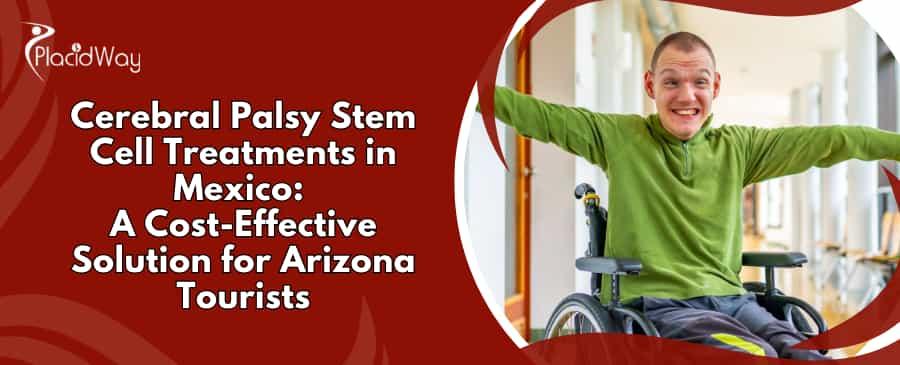
Cerebral Palsy Stem Cell Treatments in Mexico: A Cost-Effective Solution for Arizona Tourists

Cerebral palsy (CP) is a group of neurological disorders that affect movement, muscle tone, and posture. For families in Arizona and across the United States, exploring treatment options can be a challenging journey. Stem cell therapy has emerged as a promising avenue, and Mexico has become a leading destination for this innovative treatment due to its advanced medical facilities, experienced specialists, and significantly lower costs.
For many, the prospect of cutting-edge medical care without the exorbitant price tag is a compelling reason to consider medical tourism. Mexico's proximity to Arizona, coupled with its reputable clinics, makes it an accessible and attractive option for families seeking hope and improved quality of life for their loved ones with cerebral palsy.
Key Takeaways
- Significant Cost Savings: Patients from the United States, including Arizona, can save 40-70% on cerebral palsy stem cell treatments in Mexico compared to the U.S.
- Comprehensive Treatment Packages: Many Mexican clinics offer all-inclusive packages that cover the medical procedure, consultations, accommodation, transportation, and translation services.
- Advanced Therapeutic Approaches: Clinics in Mexico often utilize mesenchymal stem cells (MSCs) derived from umbilical cord tissue, known for their regenerative and anti-inflammatory properties.
- Cost of Stem Cell Therapy for Cerebral Palsy:
- Mexico: $7,000 - $20,000
- United States: $25,000 - $50,000+ (often in clinical trial settings)
- Turkey: Starting from $6,000
- Thailand: Starting from $19,500
Understanding Cerebral Palsy and Its Challenges
Cerebral palsy is caused by abnormal brain development or damage to the developing brain, affecting a person's ability to control their muscles. The condition can range from mild to severe, impacting body movement, muscle coordination, and balance.
The challenges faced by individuals with cerebral palsy and their families are multifaceted. They often include physical difficulties, such as problems with walking, grasping objects, and speaking. Additionally, there can be associated conditions like intellectual disabilities, seizures, and vision or hearing problems. The ongoing need for therapies, medical equipment, and specialized care can also create a significant financial and emotional burden.
The Promise of Stem Cell Therapy for Cerebral Palsy
Stem cell therapy for cerebral palsy focuses on the remarkable ability of stem cells to repair and regenerate damaged tissues in the brain. The goal is to improve motor function, reduce spasticity, and enhance overall neurological function.
This innovative treatment involves introducing new stem cells into the body, which can then differentiate into various cell types, including neurons and other brain cells. These new cells have the potential to replace damaged cells and create new neural connections, leading to improved communication between the brain and the body. The anti-inflammatory properties of stem cells also help to reduce inflammation in the brain, which can contribute to further damage.
[Image Placeholder: An infographic illustrating how stem cells work to repair damaged brain tissue in cerebral palsy.]
Types of Stem Cells Used in Treatment
The most common types of stem cells used in the treatment of cerebral palsy are mesenchymal stem cells (MSCs). These cells are multipotent, meaning they can develop into a variety of cell types, and are known for their strong regenerative and anti-inflammatory capabilities.
MSCs are typically sourced from:
- Umbilical Cord Tissue: This is a rich and ethically sourced supply of young, vibrant stem cells.
- Bone Marrow: Stem cells can be harvested from the patient's own bone marrow (autologous) or from a donor (allogeneic).
- Adipose (Fat) Tissue: Similar to bone marrow, fat tissue contains a patient's own stem cells.
The choice of stem cell source depends on the specific clinic and the individual patient's needs.
The Stem Cell Treatment Procedure in Mexico
The procedure for stem cell therapy in Mexico is a carefully planned process that prioritizes patient safety and optimal outcomes. It typically involves an initial evaluation, the administration of stem cells, and a period of follow-up care.
A typical treatment journey includes the following steps:
- Initial Consultation and Evaluation: Medical records, including MRI scans, are reviewed by the clinical team to determine the patient's candidacy for stem cell therapy. A personalized treatment plan is then developed.
- Stem Cell Administration: The stem cells are usually administered through one or a combination of the following methods:
- Intravenous (IV) Infusion: Stem cells are delivered directly into the bloodstream.
- Intrathecal (IT) Injection: Stem cells are injected into the cerebrospinal fluid, allowing them to directly reach the brain and spinal cord.
- Supportive Therapies: Many treatment packages in Mexico include complementary therapies such as physical therapy, occupational therapy, and speech therapy to maximize the benefits of the stem cell treatment.
- Follow-up: After the treatment, clinics provide guidance on aftercare and may schedule follow-up consultations to monitor progress.
Did You Know?
Many reputable clinics in Mexico adhere to international standards and are regulated by COFEPRIS (the Federal Commission for Protection against Sanitary Risks), which is the Mexican equivalent of the FDA in the United States.
The Cost of Cerebral Palsy Stem Cell Treatment: Mexico vs. Other Countries
One of the most significant advantages of seeking stem cell therapy in Mexico is the substantial cost savings. The lower operational costs in Mexico allow clinics to offer high-quality treatments at a fraction of the price in the U.S. and other Western countries.
Here is a comparative table of approximate costs for a comprehensive cerebral palsy stem cell treatment program:
| Country | Average Cost Range (USD) |
| Mexico | $7,000 - $20,000 |
| United States | $25,000 - $50,000+ |
| Turkey | $6,000 - $15,000 |
| Thailand | $19,500 - $30,000 |
Note: These are estimated costs and can vary depending on the clinic, the specific treatment protocol, and the individual patient's needs.
Candidacy for Stem Cell Therapy
Determining who is a good candidate for stem cell therapy for cerebral palsy is a crucial step. The decision is made by a qualified medical team after a thorough evaluation of the patient's medical history and current condition.
General factors that are often considered include:
- Age of the patient: While there is no strict age limit, the potential for improvement may be greater in younger patients.
- Type and severity of cerebral palsy: The treatment may be more effective for certain types of CP.
- Overall health of the patient: The patient should be in stable health to undergo the procedure.
- Realistic expectations: It is important for patients and their families to have a clear understanding of the potential benefits and limitations of the treatment.
Risks and Aftercare
While stem cell therapy is generally considered safe, like any medical procedure, there are potential risks and side effects. These are typically minimal and may include temporary fatigue, headache, or low-grade fever.
Choosing a reputable and experienced clinic significantly minimizes these risks. After the treatment, a comprehensive aftercare plan is essential for maximizing the benefits. This often includes:
- Continuing with prescribed therapies: Physical, occupational, and speech therapy are crucial for helping the body integrate the improvements from the stem cell treatment.
- A healthy lifestyle: A balanced diet and regular exercise can support the body's healing and regeneration processes.
- Following the doctor's instructions: Adhering to the post-treatment guidelines provided by the clinic is vital for a successful outcome.
Expert Insight
"The combination of stem cell therapy with intensive rehabilitation is key to achieving the best possible outcomes for patients with cerebral palsy. The stem cells create a window of opportunity for the brain to repair and form new connections, and the therapy helps to solidify those gains." - Dr. Maria Gonzalez, Regenerative Medicine Specialist
Choosing a Clinic in Mexico
Selecting the right clinic is a critical decision for families considering stem cell therapy in Mexico. It is essential to conduct thorough research and choose a facility with a proven track record of safety and success.
Key factors to consider when choosing a clinic include:
- Accreditation and Licensing: Ensure the clinic is licensed by COFEPRIS and adheres to international standards.
- Experience of the Medical Team: Look for doctors and specialists with extensive experience in regenerative medicine and treating cerebral palsy.
- Patient Reviews and Testimonials: Reading about the experiences of other patients can provide valuable insights.
- Transparency in Treatment and Costs: The clinic should provide clear information about the treatment protocol, what is included in the cost, and any potential additional expenses.
[Image Placeholder: A picture of a modern, clean, and professional-looking stem cell clinic in Mexico.]
Frequently Asked Questions (FAQs)
1. Is stem cell therapy a cure for cerebral palsy? No, stem cell therapy is not a cure for cerebral palsy. However, it has shown significant potential in improving motor function, reducing spasticity, and enhancing the overall quality of life for individuals with the condition.
2. How long does it take to see results after the treatment? The timeline for seeing improvements can vary from patient to patient. Some may notice changes within a few weeks, while for others, the most significant progress may be observed over several months as the body continues to heal and regenerate.
3. Is it legal to get stem cell therapy for cerebral palsy in Mexico? Yes, stem cell therapy is a legal and regulated medical procedure in Mexico. Reputable clinics operate under the guidelines of COFEPRIS.
4. What kind of support is available for international patients, such as those from Arizona? Many clinics in Mexico that cater to medical tourists offer comprehensive support services, including assistance with travel arrangements, accommodation, airport transfers, and translation services.
5. Are the stem cells used in Mexico ethically sourced? Reputable clinics in Mexico use ethically sourced stem cells, often from umbilical cord tissue that is donated with informed consent after a healthy birth.
6. What are the success rates of stem cell therapy for cerebral palsy in Mexico? Success rates can vary depending on the individual patient and the severity of their condition. However, many patients experience significant improvements in motor skills, muscle tone, and overall function.
Your Next Steps with PlacidWay
Navigating the world of medical tourism can be complex. PlacidWay is here to help you connect with trusted and accredited clinics in Mexico for cerebral palsy stem cell treatment. We provide comprehensive information, support, and guidance to ensure you make an informed decision and have a seamless and positive experience.
Customer support service by UserEcho

